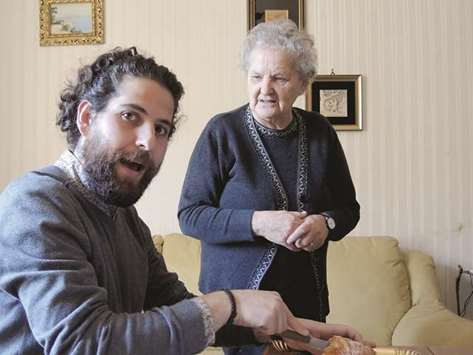It’s just as bleak in real life as it sounds in the books: cables hang from satellite dishes; the grey facades of the buildings look as if someone has given up trying to clean them.
Above the countless antennae on the rooftops, Mount Vesuvius rises up on one side and skyscrapers on the other.
Those who know the working class Naples neighbourhood of Rione Luzzatti are convinced that it is the setting of Elena Ferrante’s bestselling novel My Brilliant Friend and its sequels.
The Naples saga has made Ferrante into an international literary sensation, but her name is a pseudonym and it is still unclear who she really is.
The books are set in a neighbourhood that Ferrante calls Rione. The main protagonists are two girls, Elena and Lila, who grow up there during the 1950s. They go to school and experience conflicts and violence between the different families in the neighbourhood.
One leaves Rione behind, returning only for visits, while the other has to help her father in his shoemaker’s workshop from a young age, marries young and is then torn apart by work and family.
The novels moved 29-year-old Rione Luzzatti native Ottavio Sellitti, a photographer and literature expert, to begin examining his home in more depth.
He began photographing the neighbourhood and his photos are currently on display in Istituto Di Cultura in Berlin, where he now lives.
The photos give an insight into the world of Ferrante, whom some believe to be the Italian translator Anita Raja.
There’s the Stradone, a 1.5-kilometre-long street, once lined with trees, which links Rione Luzzatti to the central station. And there are the factories and markets, most of which are now empty.
“But lots of things remain as they were before,” says Sellitti. The entrances to tunnels are as dark as Ferrante describes them. And the low, grey houses are there too, as well as the library, where Lila, ever hungry for knowledge, borrows her books.
Sellitti’s grandmother Concetta still lives in Rione Luzzatti. In her apartment, she lays out coffee and sfogliatelli, a traditional Neapolitan pastry.
Like Lila, she married the son of the owner of a salumeria, a delicatessen specialising in salami. When she talks about the neighbourhood, you can hear the sobering tones which characterize Ferrante’s writing.
“After the war it was really clean here. The streets weren’t full of cars like today,” she says. “Back then, people longed for wealth. Now we have wealth, but not like earlier.”
There’s not a lot left of the dreams people had during Italy’s economic miracle in the late 1950s and early 1960s.
From the Sellittis’ roof terrace, the glass skyscrapers are easy to see, and are perhaps what Ferrante meant when she wrote about the “symbol of a bright future.”
Even if there isn’t an equivalent in Naples for every place mentioned in Ferrante’s books, her readers will nevertheless find the traces of many of them.
The New York Times once wrote that her books were a sort of guide which could help tourists not with the city’s sights, but rather with its social, economic and geographic divisions.
The observation has been recognised by tour guides and hotels, which now offer tours inspired by Ferrante - taking in everything from Rione Luzzatti itself to the city’s Piazza Garibaldi central square.
Sellitti believes Ferrante’s novels are a lot more than just a Naples saga. The life that she describes in Rione, shaped as it is by violence, conflicts and rivalries as well as the hopes of Elena and Lila, represents life in all corners of the world, he says.
“These stories could take place anywhere,” he says. “It could be yours or mine. On the peripheries of Paris and Berlin, the same relationships and contradictions exist as here.” – DPA

WITH GRANDMOTHER: Italian photographer Ottavio Sellitti with his grandmother Concetta.
